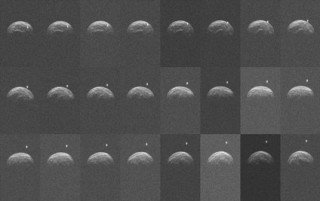Jan 31 2015
A team of astronomers using the National Science Foundation's Green Bank Telescope (GBT) in West Virginia and NASA's Deep Space Network radar transmitter at Goldstone, California, has made the most detailed radar images yet of asteroid 2004 BL86.
 Collage of radar images of asteroid 2004 BL86 made by the Green Bank Telescope from radar transmitted from NASA's Goldstone Deep Space Network antenna. Credit: NASA/JPL-Caltech; NRAO/AUI/NSF
Collage of radar images of asteroid 2004 BL86 made by the Green Bank Telescope from radar transmitted from NASA's Goldstone Deep Space Network antenna. Credit: NASA/JPL-Caltech; NRAO/AUI/NSF
The images, which were taken early in the morning on Jan. 27, 2015, reveal the asteroid's surface features in unprecedented clarity. At the time of the observations, the asteroid was traveling away from the Earth, so its distance varied from 1.3 million to 1.6 million kilometers, or about three-and-a-half to four times the distance from the Earth to the Moon.
To make these images, a continuous radar signal was sent from the transmitter at Goldstone to the asteroid. The reflected signal was then received by the 100-meter diameter dish of the GBT in a process known as bistatic radar imaging.
The GBT images also confirmed the presence of a small moon-like companion zipping around the asteroid, which was previously detected with ground-based optical telescopes by Joe Pollock of Appalachian State University in Boone, North Carolina, and Petr Pravec of Ondrejov Observatory in the Czech Republic.
Radar Enables Better Resolution
Radar images are particularly valuable in studying asteroids because they enable very high-resolution imaging. At the distance of the GBT observations, ground-based optical telescopes would produce images with a resolution of about 100 meters per pixel, so the asteroid would appear as a smudgy blob. The resolution of radar images, however, depends on how the signal is coded and the strength of the return signal, not the size of a telescope lens or mirror. With the GBT's newly installed data acquisition equipment, the astronomers were able to create images with a resolution as fine as a few (3.75) meters, revealing distinct surface features.
"There are a lot of fascinating features in these images, including possible evidence for several ridges at different latitudes," said Lance Benner, a scientist with NASA’s Jet Propulsion Laboratory in Pasadena, California, and a member of the observing team.
The images also clearly establish that 2004 BL86 is a rounded object with an apparent equatorial bulge, which was also seen in the earlier Goldstone observations. In the latest images, the orientation reveal more of the asteroid’s equator, providing a clearer picture of that region. The collage of images also shows the rapid motion of the asteroid’s moon relative to its companion.
Further analysis of the images could provide important insights into the formation and evolution of this object.
"Capturing an object this small, about half a kilometer across, at such a tremendous distance with this clarity is truly amazing," said Michael Busch, a research scientist at the SETI Institute in Mountain View, California, and a member of the observing team. "This level of detail is similar to fly-by observations obtained by spacecraft," he noted.
Radar Speckles Unlock Other Details
Concurrently with the radar imaging, the scientists also used the radar transmitter at the Arecibo Observatory in Puerto Rico and a portion of the antennas that are part of the National Radio Astronomy Observatory’s (NRAO) Very Long Baseline Array (VLBA) to perform an observation known as radar speckle tracking. This technique uses the seemingly chaotic radar pattern reflected by the uneven surface of an asteroid as it sweeps across the surface of the Earth to determine how fast and in what direction it's tumbling. Once analyzed, these data will also reveal important details about its internal physical properties and future trajectory.
The asteroid 2004 BL86 is approximately 300 meters across and its moon is a mere 70 meters across. This size comparison is not evident in the radar images because of the way they were processed. Approximately one-sixth of asteroids in this size range (200 meters or larger) sport at least one companion.
"It was enjoyable and a great privilege to participate in this experiment," remarked NRAO astronomer Frank Ghigo who assisted with the GBT portion of the observations.
The 100-meter Green Bank Telescope is the world's largest fully steerable radio telescope. Its location in the National Radio Quiet Zone and the West Virginia Radio Astronomy Zone protects the incredibly sensitive telescope from unwanted radio interference, enabling it to perform unique observations.
The National Radio Astronomy Observatory is a facility of the National Science Foundation, operated under cooperative agreement by Associated Universities, Inc.